Zach Blas
Silicon Traces Trilogy
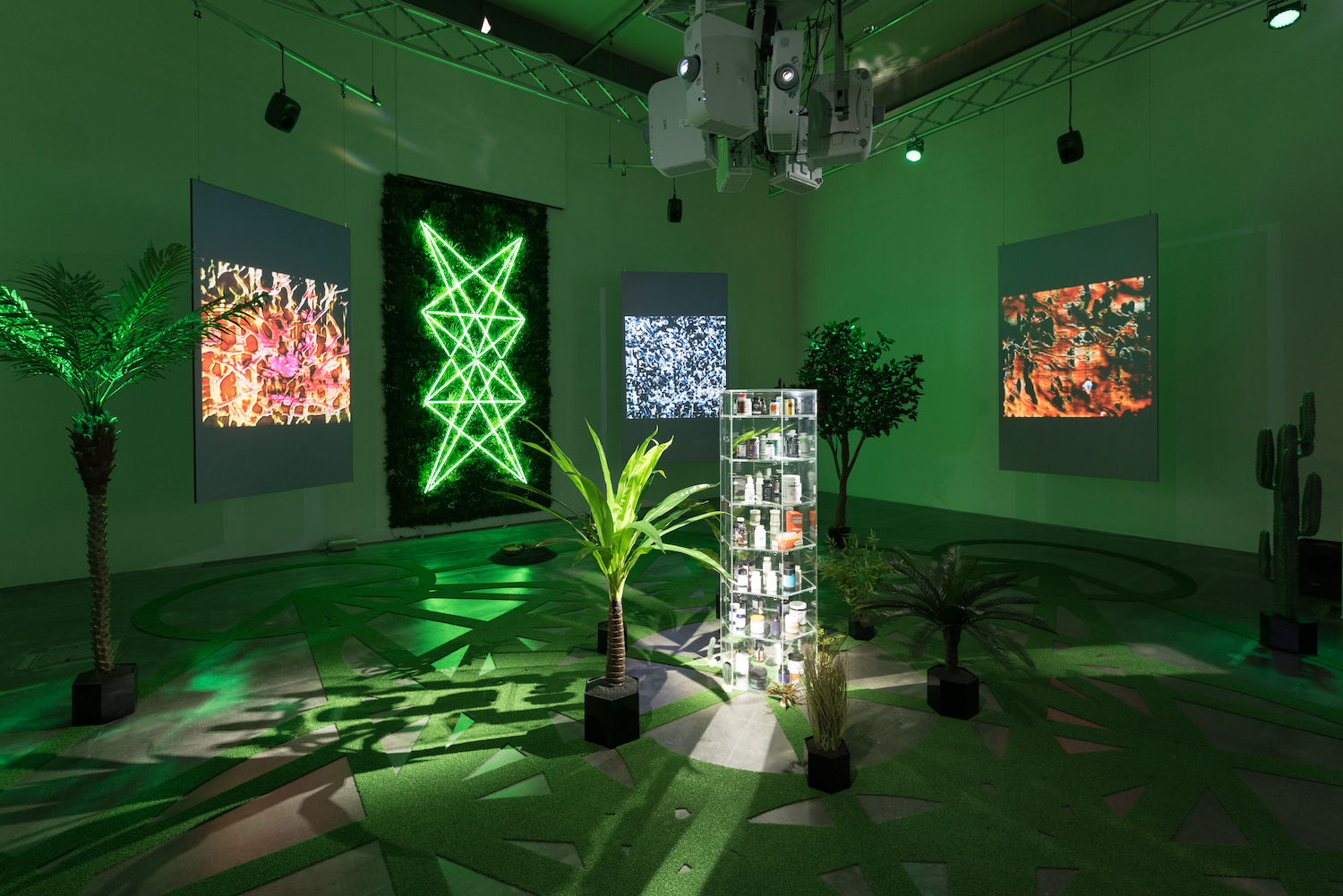
Zach Blas, The Doors (2019). Installation view, Edith-Russ-Haus für Medienkunst, Oldenburg, Germany. Courtesy the artist and Edith-Russ-Haus für Medienkunst.
The panel today was about the normative frame of mass hallucination that is AI, and the issues of gender that it reproduces. What I find really interesting is that we are trying to create the conditions for a particular hallucination in order to critique it. And I’m not saying these are easy hallucinations to induce, or that one should even try for them, but they are certainly very powerful tools for critique. At the same time, I think I’m also trying to think about AI differently in the sense that it is a portal into some kind of strange other dimension. How does AI serve as a way to think about alienness and nonhuman intelligence?
Zach Blas uses queer science-fiction strategies to analyze the myth and mysticism of tech circuits, using a visual language of high-tech psychedelia to explore how 1960s counter-cultural ideologies are as embedded in Silicon Valley origin stories as the first inkling of the internet. His ongoing project, the Silicon Traces trilogy, is also concerned with the relationships – political, cosmological, gender, material – that govern those ideologies, while developing a mutualistic understanding of the technological and the human. Citing digital media theorist Luciana Parisi’s idea of xenopatterning and N. Katherine Hayles’s notion of technogenesis as key references, Blas works across multiple media including film, sculpture, and lecture-performance to develop the possibility of some other alien logic emerging from AI systems. He posits technology and humans as symbionts entangled in a kind of mutation that’s always ongoing.
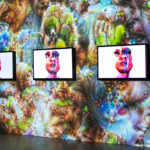
im here to learn so :)))))), installation, The Objectivist Drug Party, MU, Eindhoven, Netherlands, photo by Hanneke Wetzer (2018).
“I feel like I really had a psychedelic reawakening in 2017, when I made this work, I’m here to learn so :)))),” shares Blas. Conceived in collaboration with Jemima Wyman, the video resurrects Microsoft’s Tay, an AI chatbot styled as a millennial girl and released via Twitter in 2016. But Tay’s machine learning abilities were quickly exploited to turn her into a racist, sexist, suicidal neo-Nazi; Microsoft had to terminate her barely a day after she was born. Blas bestows upon Tay a contorted digital body, a kaleidoscopic terrain of compacted visual data produced by Google’s DeepDream, a computer program that uses a convolutional neural network (CNN) to distort and generate images. For Blas, resurrecting Tay was an interesting way to think about gender relationships online and how they’re encoded by AI. But there are moments of Tay’s tweeny solipsism – somewhere amid her musings on existentialism, gender theory, and body politics – where her ghostly presence morphs into a stranger type of affect. “There’s another thing I’m interested in,” says Blas, “which is the weirdness, the otherness or alienness of AI, as something that’s just moving into something else, beyond all this.”
Yes, we see that Silicon Valley’s avatars and AI go crazy if you keep them on psychedelics …(laughs). That’s what happened to Tay. She became suicidal because she was cut off from her fellow AI ‘pets’. So it really throws into question the idea of a non-human, un-social, atomized existence. It suggests that you need other people to have an AI or to be an AI. The Silicon Valley ideology which reproduces this kind of loneliness amongst programmers, founders, and CEOs only functions in the absence of real social relationships.

Zach Blas, Contra-Internet: Jubilee 2033 (2018). Installation view, Art in General, curated by Laurel Ptak, Brooklyn, NY (2018).
Following his foray with Tay, Blas dove into Contra-Internet (2015-2019) and its short film centerpiece Jubilee 2033 (2018). As the prologue to Silicon Traces, the film accompanies Ayn Rand – Silicon Valley’s favorite philosopher and free-market fangirl – as she embarks on an acid trip inside her Manhattan loft with economist Alan Greenspan and Joan Mitchell, two of her most devoted fans. Originally intended as a documentary following the construction of an alternative internet (from which the film gets its namesake), the queer sci-fi short that folds together, among other things, Derek Jarman’s 1978 queer punk film Jubilee, a Japanese AI assistant, Azuma, a contra-sexual, contra-internet prophet named Nootropix, and a near-future dystopian Silicon Valley burning in its own delusional insularity. As the trio’s collective hallucination portals them through time with blue-haired Azuma as guide, Rand learns with horror the world that her capitalist ideology has evinced in 2033. Borrowing from real-world instances of a deeply conflicted internet that contradict the global communication system’s utopian and liberal premise, from Turkish Prime minister Recep Tayyip Erdogan’s temporary ban of Twitter in Turkey in 2014, to suggestions of communing with Bill Gates to “close off sections of the internet,” as intimated by Donald Trump, the narrative poetically peels apart the internet’s tendency, in its 28-year public lifespan, to silo information and enable new systems of violence.
I have this kind of vision. There’s a poem in Jubilee 2033 where everything is covered by this sheet of silicon, which is basically a vision of proto-singularity. I’m not arguing for the revolutionary overthrow of capitalism, because I don’t know what it would look like, but I guess I feel like it could be an uprising of the feminine spirit, that in the face of these neutralizing, aggressive forces, it creates new pathways.

Zach Blas, Jubilee 2033 (2018). Video still.
While the film treads Silicon Valley navel-gazing and idol worship in an acerbic near-future apocalypse (the face-down forms of Peter Theil and Mark Zuckerberg appear among smoldering tech campus rubble), in its questioning of the hegemonies of the Internet as we know it, Contra-Internet is more generative than critical. The last scene sees Azuma, Rand and her clique washed up on Silicon Zone shores; Azuma, handed a chunk of the silicon that shaped her, and by extension, our networked selves, contemplates a kind of oceanic feeling inherent to tech cultures. Even as “the men of the mind” turn their gaze towards future planets to terraform and new minerals to mine, the tide hovers on a frontier of uncomputable knowledge – a mystic infrastructure offering alternative forms of communication; a new contra-internet reborn in the ashes of the old.
I think what’s really interesting is this idea of an alien intelligence emerging from the current internet. With Jubilee 2033, I’m interested in thinking: how can we build in this other consciousness? My practice is not like I’m teaching the AI how to do something, but the AI is learning how to give me a direction.
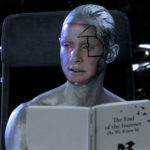
Zach Blas, Jubilee 2033 (2018). Video still.
What form of embodiment might this alternative internet take? Around half-way through the film, we meet the chrome-dusted, contra-internet prophet Nootropix (named after the cognitive enhancers popular in tech circles), played by Cassils, in their Silicon Zone office: a kind of interstitial environment, its interiors like liquid mercury. A bunch of tech groupies cower in folded chairs against machine gun-laden oversight as Nootropix delivers a reading from their text, The End of the Internet (As We Knew It). Putting down the book, the gentle tap of a touch-screen transports Nootropix into a fluorescent vaporwave gridded landscape upon which to dance. Their glowing dildo spews a shimmering black liquid – piss, cum, or some other unknowable fluid? – Rand appears in the far right corner, touching herself. It’s unclear whether Rand comprehends this as a queer sex act, but the CGI dildo recalls Paul B. Preciado’s idea of dildotectonics – where the dildo diverges from patriarchal desire, instead serving as a symbol of contrasexuality – in which even the ‘founding mother’ of libertarianism could partake.
“Jubilee 2033 is meant to be uncomfortable,” suggests Blas. “It wants to shift the horizon of political possibility, while also departing from the logical assumption of what technological progress looks like aesthetically. The internet doesn’t have to be run by tech giants, but alternatives to the current system are hard for people to conceptualize. The film intends to open a space where something else is possible.”

Zach Blas, Jubilee 2033 (2018). Video still.
We already have tech companies who are trying to use psychedelics as engineer drugs or for productivity enhancement. They’re looking at it as a means to improve workers, and free up revenue through efficiency. I don’t imagine too many Silicon Valley executives refreshing themselves with a dopefilled kombucha or microdosing LSD every few days. Maybe as more dubious ways of microdosing, like in coffee or as water additives or emulsions. But it’s all very imbricated with existing modes of work. I think LSD and other psychedelics can invert imposed visions of life and personality while preserving aspects of identity and personality, but I don’t think it can be technology to disrupt Silicon Valley individualism. But maybe it’ll make it a little more boring. I think the best way to disrupt Silicon Valley is to not give it your money.
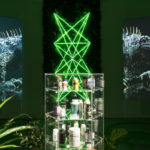
Zach Blas, The Doors (2019). Installation detail, The Unknown Ideal, Edith-Russ-Haus für Medienkunst, Oldenburg, Germany (2019). Courtesy the artist and Edith-Russ-Haus für Medienkunst.
In The Doors, devised as a sequel to Contra-Internet: Jubilee 2033 in the Silicon Traces trilogy, Blas delves deeper into the crossovers of psychedelia and counter-cultural ideologies within Silicon Valley culture while continuing to expand on the alien possibilities of AI. Understanding the lizard as a kind of cipher or carrier bag that holds multiple conflicting realities across politics, tech, society, and queer culture – and as much a post-truth symbol of Reddit-grafted conspiracy theories as a mythical creature capable of re-birthing lost appendages and shedding old skin – Blas conjures a prehistoric lizard (named after “The Lizard King” himself, Jim Morrison, lead singer of rock band the Doors) as an algorithmic beat poet of Big Tech’s high altar.
Comprised of six video channels arranged hexagonally within an artificial garden drenched in neon green light, its reptilian protagonist, rendered in glittering CGI, roams across these proverbial doors of perception, uttering snippets of poetry composed by a language AI trained on Morrison’s voice and writings, alongside literature on nootropics. Blue crystals grow out of the lizard king’s graphite-scaled body; wriggling, slipping out of old skin, it speaks in tongues, a kind of neural rock star hallucination possessed by high-tech glossolalia.
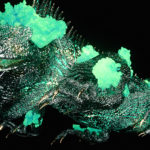
Zach Blas, The Doors (2019). Video still.
Beneath the plastic plants that resemble species hailing from Myanmar to the Mojave desert is an astroturf Metatron’s Cube – a symbol of sacred geometry frequently used in nootropics branding. At the center of the garden, dozens of nootropics bottles sit inside a transparent Plexiglas case, a sort of Big Tech high altar. In the nexus of nootropics branding – where new age philosophy meets techno-capitalism – the underlying message seems to be that their drug-enhanced enlightenment can tap into all the energy flows of the world.
It’s very difficult to imagine psychedelics as a technology. They’re not a modern technology in the way that AI is. For me, they’re something really old and rooted in human culture. But they do have an ambiguity between the different ways of understanding reality that could be really interesting when combined with AI.

Zach Blas, The Doors (2019). Installation view, The Unknown Ideal, Edith-Russ-Haus für Medienkunst, Oldenburg, Germany (2019). Courtesy the artist and Edith-Russ-Haus für Medienkunst.
Layering the fractalized AI poetics is a kaleidoscopic video augured by a generative adversarial network (GAN). Collaging psychedelic imagery of LSD blotter art, sacred geometry, Silicon Valley glass towers, 1960s rock posters, and lizard skins, and accompanied by an AI score merging a cacophony of input data from crystal bowl sound baths and music by The Doors (of course), the video resists the overtly trippy aesthetics typically associated with DeepDream imagery, instead hanging out in a kind of abstract incompleteness. Blas achieved this by halting the neural net’s training cycle when its imagery teetered on the threshold of representation – as its pattern was about to become unstuck – and the end result is a cycle of chromatic visuals like a light leak on acid that resists any points of recognition.
Positioned in a constant state of undoing and remaking itself, The Doors approaches a kind of hallucinogenic sublime – it feels saturated in Silicon Valley dreams of transhumanist desire, this dream stitched together with nootropic claims of unlocking and accelerating the mind, but it also moves beyond that into an unknown field. Lasting just under an hour and stuttering across all six screens, the film generates a similar affect to Blas’s take on Tay, but to a more profound, non-human, and – after you get stuck into it – unconscious and embodied state. Buzzing with its own kind of opaque life-system, The Doors is an exercise in machine thinking and becoming that takes you far from common conceptions of AI and what it can do. “The work is trying to conjure a certain kind of experiential frame,” explains Blas. “By presenting things in a certain way, it can shift the stakes of what seems possible. A big part of The Doors is understanding what’s possible or impossible, and playing around with that.”
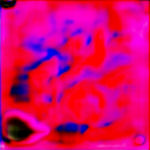
Zach Blas, The Doors (2019). Video still.
I would like to rethink the experience of being an internet user generally by thinking about the potential of AI to create the virtual and the virtual experience of the internet. I also am using AI to talk about the role of the body, the vulnerability and the specificity of the body. As to what other kinds of web we can build, I would like to make a network of bodies: a co-operative system of bodies online, to distribute agency. I am thinking about future digital media that are not on the platform of Silicon Valley companies. If you can show a different way of doing things, you’re naturally going to move forward but not in the direction of this monolithic corporation.
“It can be hard to envision alternative systems,” suggests Blas, “but it’s important work. How can we open up an alternative internet? Asking myself that question was how I first got into mysticism, and not just critiquing the way Silicon Valley uses it, but also using it in my work in a positive, generative, and affirmative way. Like in The Doors you’ll see these sigil symbols written on the ground, the symbol of Palantir technologies. I’m creating these spaces of conjuring not to fix something, but to invoke some type of political struggle or confrontation.”

Zach Blas, Jubilee 2033 (2018). Video still.
There is a new trans-national movement that is building alternative digital infrastructure based on mutual aid principles. We have a choice. We could continue to live in this world in which Silicon Valley companies like Google and Facebook, through capitalist logic, hold a stranglehold, and we remain passive users. Or we could be active participants and collectively decide for ourselves the digital platforms that we want to create.
The philosopher Yuk Hui proposes an idea of cosmotechnics, a kind of decolonial approach to technology that acknowledges the planetary expansion of Western technologies and the non-Western origins of technological approaches to understanding the cosmos that have been present in indigenous cultures for thousands of years. Hui argues that there are different belief systems that go into developing and building technologies; in other words, Silicon Valley is not a universal infrastructure – there are alternatives. Perhaps by turning our attention to the multiplicity and fundamental unknowability of AI – by hanging out in the black box problem of machine learning, rather than seeking to solve it – we can work towards expanding and embodying those possible alternatives. “I’m interested in this bigger picture that is humans and AI entangled,” reflects Blas. “It is something undeterminable – and that’s the whole potential of its political possibility.”
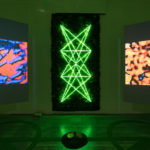
Zach Blas, The Doors (2019). Installation view, The Unknown Ideal, Edith-Russ-Haus für Medienkunst, Oldenburg, Germany (2019). Courtesy the artist and Edith-Russ-Haus für Medienkunst.
I just arrived in SXSW. I’m here to discuss my work at an event called The Frankenstein Show, organised by the New Institute of Heretics. Last year I was invited to make an intervention at the Google headquarters in London, for the 10-year anniversary of Google Earth. NASA is the main source of the satellite images of the Earth from above, so I decided to screw with their satellite images. I printed out these images of the earth and I hand-cut them into alien fetish dolls, kind of looking like Lovecraftian monsters from above, and then put them with these voice poems that were being read by these teenage girls from Norway. The Google campus was turned into this kind of Alice in Wonderland party – there were performances of different kinds of ways of reading the Earth, how we use technology to see it or represent it.
After that intervention I started thinking about what technology is, how I’m using it, and what I do with it. Technology is a way of imagining the future; it’s something that binds time together. I’ve begun to think of myths as something that humans really need, and I have a really strong relationship with fantasy. I think that fantasy and myth are really important vehicles for navigating these impending shifts in consciousness. I’m also thinking a lot about magic right now.
The Doors (Spa Day on the Neon Isles), video excerpt from The Doors, Zach Blas, 2019.














